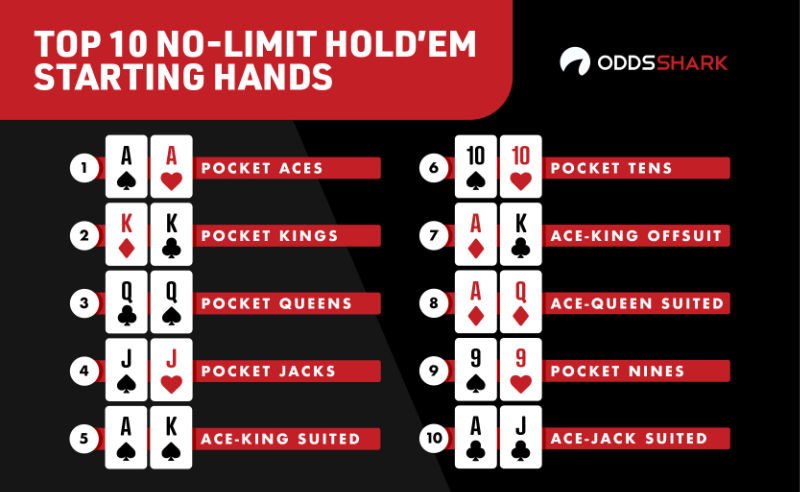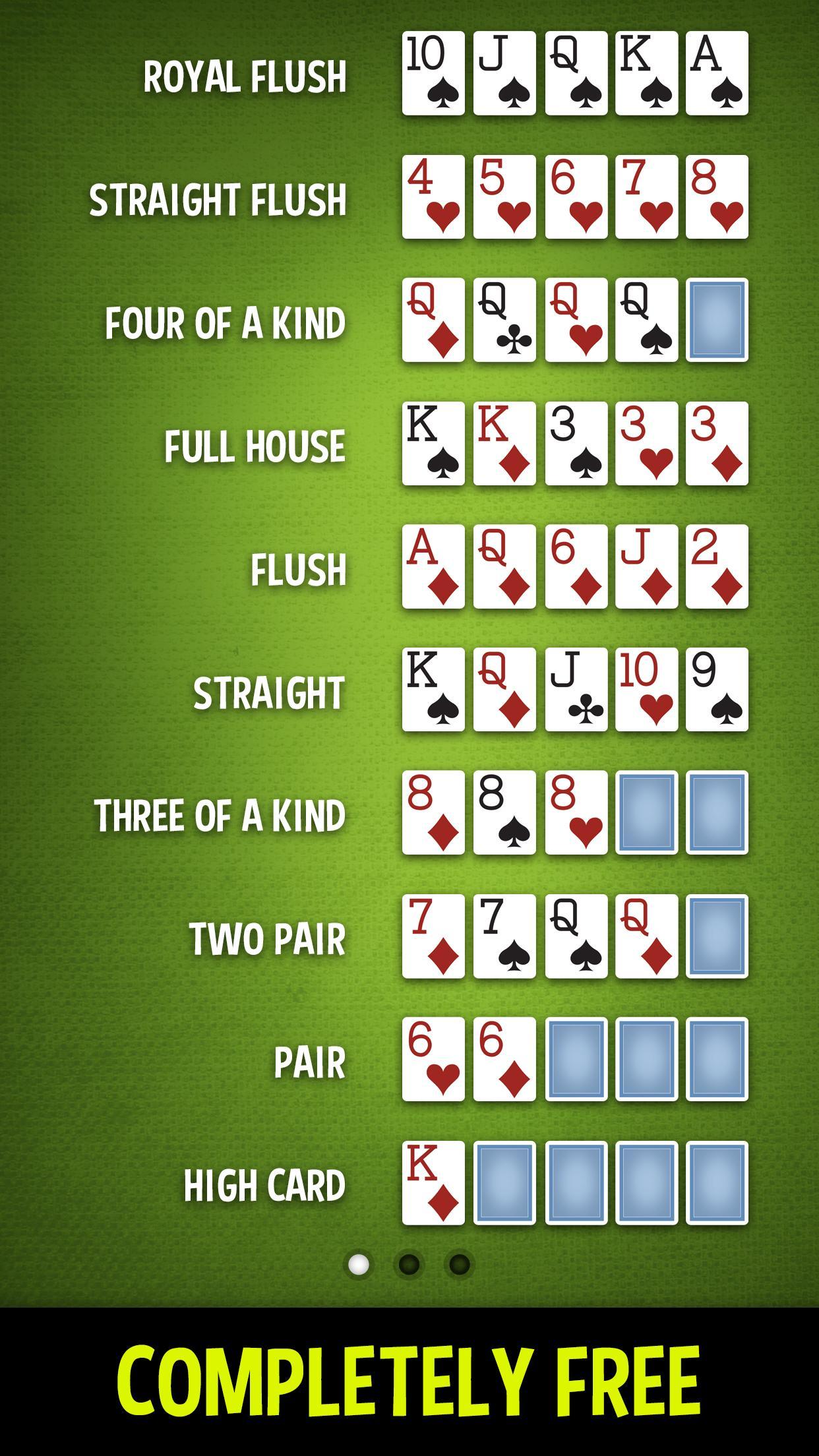Hand Rankings Holdem
The rank of hands remains the same no matter which type of poker game you play. In a nutshell, a poker hand consists of five cards. Poker hands fall into one of several categories, such as flush, straight, or two pair. The player with the highest ranking hand is the winner. Two aces is the best Hold'em poker hand you can hope to have. It's the best of the best, and it will win you more than any other hand. It's also known as American Airlines, pocket rockets, and bullets. Poker Hand Rank. Here is the standard hand rank, from highest to lowest: A royal flush is a hand where all the cards are of the same suit and the 5 highest cards in consecutive order (10, J, Q, K, A). This hand is the best hand that you can get in the game of Texas Hold’em.
In poker, players form sets of five playing cards, called hands, according to the rules of the game. Each hand has a rank, which is compared against the ranks of other hands participating in the showdown to decide who wins the pot. In high games, like Texas hold 'em and seven-card stud, the highest-ranking hands.
6+ Hold’em is a popular ‘short deck’ poker format that plays much like Texas Hold’em, but with a few exciting differences:
- All cards lower than a six are removed from the deck
- Everyone posts an ante and only the button posts a blind – known as the ‘button blind’
- A flush beats a full-house
Available in cash games, exclusively at PokerStars, 6+ Hold’em is your chance to play an action-packed variant loved by high-stakes players around the world.
Let’s face it – fives, fours, threes, and twos got in the way a little bit in regular Holdem. They were consistent contributors to dry boring flops, blank turns, and no one ever making a hand. 6+ Hold’em (known conventionally as ‘Short Deck’) has been taking the poker world by storm and giving jaded long-term players a fresh breath of life as they gamble it up in this wild format of the game played with a 36-card deck. Six Plus is exactly as it sounds. There is no card in the deck below a six. As you can imagine, this leads to a lot less discoordination and makes it far easier to make a strong hand. When I first saw this game, I recall my first thought being:
‘Wait a second…it’s almost impossible not to make a straight!’
While this is a huge exaggeration. I think it captures the instinctive reaction of most players. Regular Holdem players must adapt quickly in 6+ Hold’em, migrating from a world where good hands are relatively rare, to one where they come along much more frequently. We shall get into the strategic effects of this shift in a future article. Today’s job is to get our heads around what hand rankings and rules have changed and why these changes were necessary to make 6+ Hold’em the harmoniously enjoyable game that it has become.
Blind & Antes
6+ Hold’em uses a ‘button blind’ structure: every player posts an ante, and the player seated at the button position is the only one who posts a blind – meaning there is only one blind per hand, rather than traditional small/big blind format.
The action starts with the player seated to the left of the button. Each hand then plays out according to Texas Hold’em rules, with pre-flop, flop, turn and river betting rounds.
If you’ve played Texas Hold’em games before, the rules of 6+ Hold’em are easy to follow.
Hand Rankings
The table below illustrates how the hand rankings have changed in 6+ Hold’em to accommodate the shorter deck:
The Top Hands
There is no change at the very top of the hand ranking chart. While you will make a straight flush and a royal flush more often in 6+ Hold’em than in Holdem, it is still very hard to make these hands relative to the other hands. Four of a Kind is a hand you will see much more often than in Holdem since there are now 9 ranks of card instead of thirteen but is still rare compared with other 6+ Hold’em holdings.
Flushes vs. Boats
The main change to the hierarchy is that Flushes now beat Full Houses (boats). This makes sense and to see why think of it this way.
In regular Holdem, there are four 9s in the deck, but there are also four of twelve other ranks of card. One in thirteen cards is a nine in regular Holdem. In 6+ Hold’em, there are only nine ranks of card and so one in nine cards is a 9. If you are dealt 99, any card in the deck goes from having a 2/50 = 4% chance of being a 9 to having a 2/34 = 6% chance. In 6+ Hold’em, it is 50% easier to find those set making cards. In fact, in 6+ Hold’em you will fail to flop a set (32/34 x 31/33 x 30/32) = 83% of the time. This means that we flop a set 17% of the time! After we have done the hard part, and hit one of our two cards to make a set, it is much easier for the board to then pair since sixteen of the cards that would prevent it from pairing in regular holdem (the deuces through fives) do not exist. Those cards really did spoil all the fun.
As for flushes, they are sadly no easier to make and come along less often than a full house does. While there are less ranks of cards in the 6+ Hold’em deck, there are still the same number of suits. Had we also removed all of the diamonds from the deck, we would have made flushes more likely. As it is, every card still has a one in four chance of being a spade (13/52 = 9/36).
One thing that has changed about flushes in short deck is that when a you hold a card that blocks an opponent from making a flush, you will block a greater portion of his possible flush cards. The board is J♣8♣6♣10♠Q♥ and we hold A♥K♣. In regular Holdem, we would remove one of ten remaining clubs, leaving Villain with nine clubs to instead of ten to form a flush. In other words, there are 10% less clubs in the deck for him to make a flush with when we hold this blocker. In 6+ Hold’em, there were only six possible clubs and we reduce this number to five due to our K♣ blocker. We have now made it 17% harder for Villain to hold a flush by removing a sixth of the clubs in the deck. Blockers matter more in 6+ Hold’em in just about every way due to the smaller deck, not just when it comes to blocking flushes.
Straights vs. Trips
While it is easier to flop three of a kind in 6+ Hold’em than it is to flop a straight, it is easier to make a straight by the river. There are only 9 ranks of cards remaining in the deck so if the board doesn’t double-pair, there will be straights everywhere. A board like K♠J♠10♣8♥6♥ is scary at the best of times in regular Holdem. In 6+ Hold’em, there are no deuces through fives to dilute the number of straights in each player’s range. The result is that it is incredibly easy to hold a straight in 6+ Hold’em. Pre-flop you will be dealt [97, Q9, AQ] 48/630 times. In Regular Holdem you will be dealt these hands 48/1326 times. While there are some versions of short deck Holdem where three of a kind beats a straight, this is not the case in 6+ Hold’em and so connected cards are very powerful. This format of the game encourages action by providing an incentive to play connected cards, which come along very frequently.
We should also note that there is a rather unconventional looking straight available in 6+ Hold’em. A6789 is a low straight in 6+ Hold’em just as A2345 is a low straight in regular Holdem. Look out for this one, it can really tak you by surprise if you are not careful.
Conclusion
6+ Hold’em is a different game. Some of the rules are very different, but as we have seen, these adaptations have been necessary to ensure that the game is fair and balanced. Now that we are acquainted with the different hand rankings and hand formation rules, it is time to get stuck into some strategy. In my next article on 6+ Hold’em, I will be discussing pre-flop hand selection.
Join us on our Discord channel.
As you have enlightened your knowledge about how to play Texas Hold’em poker, the five-card combination is determined to be the best based on the hand ranking. To fathom the hand ranking better we have fabricated a few frequently asked questions (FAQ) from which you can understand the hand ranking with live game scenarios.
So let’s learn about the hand ranking ( highest to the lowest rank):
FREQUENTLY ASKED QUESTION
Qn : Straight or flush, which is a better hand?
Ans : 5 cards of the same suit is called the “flush” which is ranked higher than the “straight” that is 5 cards in a sequence. This is one of the most common confusion that rises among the new players.
Texas Holdem Hand Rankings Preflop
Qn : What if two players in the table form the same pair of combination?
Ans : In such scenarios, the pot money is equally divided between the winners. This happens only if the players have the same pair of hands or else even a single high card could change the winner.
Qn : What happens if two players form a straight hand each?
Ans : In poker, the straight’s are usually represented in higher cards like straight–to- ten (10♥, 9♠, 8♠, 7♦, 6♥) so the player forming the higher card wins the game.

For example: let us take two players A and B, say player A has two hole cards of 9♥, 10♠ and player B has hole cards of 4♠, 5♦ while the cards on the community cards are 5♥, 6♣, 7♦, 8♠, 9♦. In this case, player A (6♣, 7♦, 8♠, 9♥, 10♠) wins over player B (4♠, 5♦, 6♣, 7♦, 8♠) because player A has higher cards when compared to player B.
Qn : What happens if two players form a Full House each?
Ans : Texas Hold’em is a game of high cards hence the higher cards are always considered for the win. So the player with higher card wins the pot in such scenarios.
For example: say, player A has two hole cards of K♥, K♣ and player B has hole cards of K♠, 10♦ while the cards on the community cards are K♦, 2♣, 10♥, 8, 10♣. In such scenarios, the player A with a card combination of (K♥, K♣, K♦, 10♥, 10♣) wins over the player B with a card combination of (k♠, k♦, 10♦, 10♥, 10♣) because the player A has the highest ranking hole cards.
Qn : What happens if nobody forms any combination of cards?

Ans : In the game of poker when no player forms any combination of cards the highest ranking card wins the pot.
For example: Say, player A has A♥, 10♦ and player B has K♣, J♥ while the community cards shows the community cards of 8♣, 4♠, 2♦, 5♦, 9♥. Player A wins the pot as player A forms A♥, 10♦, 9♥, 8♣, 5♦ and player B forms K♣, J♥, 9♥, 8♣, 5♦ where A is the highest ranking card.
Texas Holdem Hands To Play
Now that you have good knowledge about how to play poker as well as the hand rankings, Log-in and kick-start your win towards big pot.